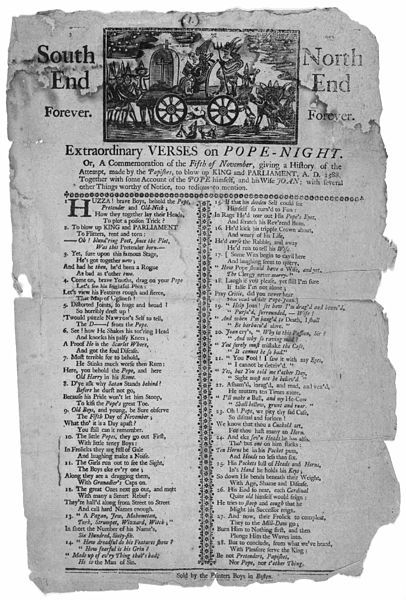While eventually focusing on New England, this article begins with the reason eighteenth-century Britain celebrated the 5th of November. Unfortunately, that explanation mixes up dynasties:
The paradox of papist ambition and secrecy became powerfully instantiated in the commemoration of Guy Fawkes Day, celebrated in England annually after 1605 on 5 November. A Catholic by the name of Guy Fawkes and several other Jacobite conspirators desired to usurp the Hanoverian, Protestant monarch, James I, to restore a contending Stuart, Catholic family line. Englishmen who supported James I called the Stuart claimant a “pretender.”James I was a Stuart—indeed, founder of the Stuart dynasty. His grandson, James II, was also a Stuart but not also a Protestant, causing Parliament to replace him with Protestant Stuarts. When that supply ran out in the early 1700s, Parliament invited in the line of Georges from Hanover. That’s when Stuart pretenders started to pose a continental, Catholic, and “Jacobite” threat to the Hanoverians.
The error, though unfortunate, is actually an apt reflection of the shifty nature of England’s established religion over two busy centuries. While the celebration of the 5th of November was rooted in the early 1600s, it took off as a holiday in New England more than a century later. Until then, the region was too often at odds with the British monarchy and Parliament to get behind celebrating their deliverance. But once the causes of anti-Catholicism, imperial pride, and respect for the king were firmly united, New Englanders were all in.
Ritter’s article digs up lots of evidence about the intellectual environment in which the holiday flourished. One of the values that united most Britons in the 1700s was that Roman Catholicism was a Bad Thing. (British Catholics didn’t hold that view, of course, but British law literally excluded them from full participation in British society.) New Englanders, with their culture’s Puritan roots, held that idea even more strongly.
As a result, during theological and political disputes New Englanders on both sides tended to accuse the other of acting too like the Catholics. Ritter quotes a New Light pioneer, the Rev. Elisha Williams, complaining in 1742 that traditionalists displayed the “true Spirit of Popery” by imposing their “Determinations on all within their Power by any Methods which may appear most effectual…in Matters of Religion.” Meanwhile, the Rev. Charles Chauncy, an Old Light leader, said even “POPERY itself han’t been the mother of more and greater blasphemies and abominations” than the New Light revivals.
As Ritter describes, Guy Fawkes was never really the focus of how New England celebrated Pope Night. Indeed, one surviving broadside about the holiday from the early 1760s misdated the Gunpowder Plot to 1588, showing how little people cared about those ancient details. Rather, the New England holiday came to lambaste contemporary enemies, starting with the Pope (not that many revelers could have told you what the current pope’s name was) and Stuart Pretender.
Eventually the “Pretender” became the name for the villain of the year being hanged in effigy. Boston’s “Pretenders” in the 1750s and 1760s included Admiral John Byng, Customs Commissioner Charles Paxton, and Governor Thomas Hutchinson. Thse effigies in turn offered meme for the Stamp Act protests of 1765 and the nonimportation pickets of 1770.
Ritter focuses a lot of attention on Massachusetts and Boston laws meant to keep Pope Night revelry from becoming too rowdy and violent, citing “tensions between elite Massachusetts-Bay legislators” and the celebrants.
While civic leaders undoubtedly worried about the violence and social disorder of Pope Night—a child was killed in 1764, after all—it’s significant that they never tried to end the celebration entirely, simply to keep it within bounds. And from the other side, I think it’s a mistake to see the holiday’s appeal for young males simply as upending authority. Rather, it was a day of misrule sanctified by also being both patriotic and pious.
As the article notes at the end, Pope Night lost its respectable rationale during the Revolutionary War. It was no longer patriotic to praise king and Parliament, and no longer politic to complain about everything Catholic when France was helping win the war. Pope Night imagery proved useful when Americans wanted to show their contempt for Benedict Arnold, but that tradition faded fast.
Mid-autumn misrule still had its appeal, though. Some Pope Night rituals hung on long enough to evolve into Halloween. But that vastly popular American holiday never regained an overt political or religious justification, despite the best efforts of UNICEF.

The even worse howler is at the end of of the paragraph -
ReplyDelete"This would not be the last Jacobite attempt to overthrow the English government — there were attempts, for example, in 1688..."
Uh, who overthrew whom in 1688? Sad that such basic errors should mar an otherwise interesting article (and not be caught by any editor).
I’m choosing the view that whole paragraph as one big error of slapping eighteenth-century labels onto seventeenth-century events. But I was surprised that glitch survived editing and peer review.
ReplyDelete